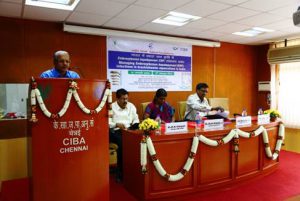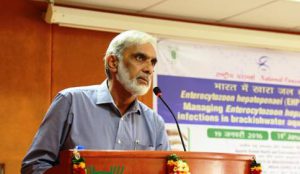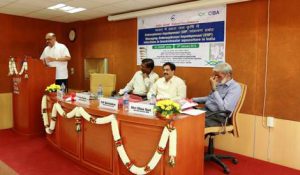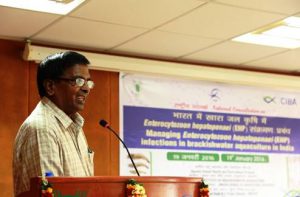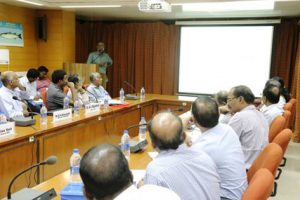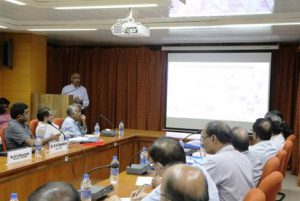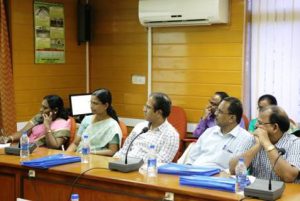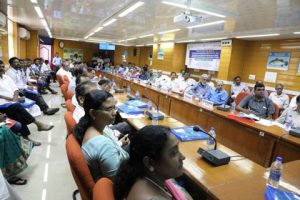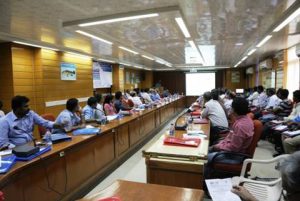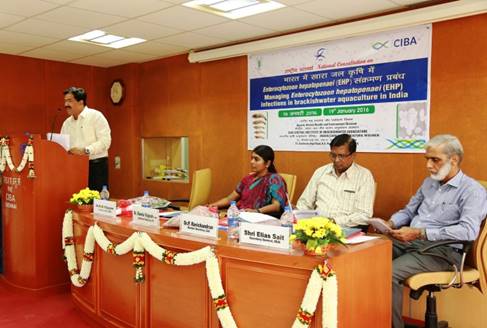The Enterocytozoon hepatopenaei (EHP) disease outbreaks have been widely reported in Asian countries like China, Indonesia, Malaysia, Vietnam and Thailand. The parasite was identified last year from Indian shrimp farms. On a follow-up study conducted by CIBA and MPEDA-RGCA, after the shrimp farmers widely reported stunted growth, which caused concern as EHP affected the size, market value and crop failure of farmed shrimp. The major farming areas affected where the state such as Andhra Pradesh where intensive Penaeus vannamei farming were taken up. The study by scientists from Aquatic Animal Health and Environment Division of CIBA and RGCA aquatic animal health laboratory in the year 2015 indicated the emergence of the parasite with widespread occurrence in Indian shrimp farming systems. This issue was discussed at the day-long workshop to draw the strategies for the control of EHP problem in India.
A one day national consultation was held on “Managing Enterocytozoon hepatopenaei (EHP) infections in Brackishwater aquaculture in India” on 19th January 2016, at CIBA Chennai. Stakeholders from the brackishwater aquaculture sector, representing scientific research institutions, universities, shrimp hatchery operators, shrimp farmers, feed manufacturers, members of Society of Aquaculture Professionals (SAP), Seafood Exporters Association of India (SEAI), officials from the Ministry of Agriculture, Department of Animal Husbandry Dairying and Fisheries, Coastal Aquaculture Authority, Marine Products Export Development Authority (MPEDA), Rajiv Gandhi Centre for Aquaculture (RGCA) and state Govt. officials participated the consultation meeting.
The EHP pathogen is yeast like fungus and belongs to a group of spore-forming unicellular parasites called microsporidia. These are obligate intracellular parasites of highly valued shrimps like tiger shrimp, Penaeus monodon and Pacific white shrimp P. vannamei. The pathogen is transmitted in shrimp directly by the oral route and causes stunted growth condition, leading to significant economic losses to the farmers, due to poor and retarded growth. Presently, there is no drug or therapeutic options available for the control of EHP infection in shrimp. Hence, adoption of better management practices and proper biosecurity measures along with stocking of EHP free shrimp seeds is the only way to keep the pathogen away from shrimp farming system.
Dr. K.K. Vijayan, Director of CIBA expressed that this was a unique consultation, wherein, all the stakeholders including the research Institutions, Fisheries Universities, the coastal aquaculture authority, Marine Products Exports Development Authority (MPEDA), Rajeev Gandhi Centre for Aquaculture (RGCA), the seafood exporters’ association of India (SEAI), officials from Maharashtra, Karnataka, Tamil Nadu and Andhra Pradesh State Govts., Society of aquaculture professionals (SAP), shrimp hatchery operators, shrimp farmers and feed companies have come together. He emphasised that resolving such issues would be easy when all the stakeholders work together for the future of aquaculture sector in the country. He urged that prevention is better than cure and BMPs are important in management of diseases such as EHP and running mortality syndrome (RMS), which appear to be largely due to bad management of the aquaculture ecosystem.
Dr. (Mrs.) Beela Rajesh, IAS, Commissioner of fisheries, Tamil Nadu, while inaugurating the national consultation said, EHP is an important disease as it causes slow growth and reduced production. She advocated to investigate the zoonotic importance of the pathogen and also emphasised the need to transfer the scientific information in the vernacular language for the benefit of the farming community. She said that this national consultation gives an opportunity to exchange views and research among the stakeholders. Mr. Elias Sait, Secretary General, SEAI, said that after introduction of Pacific white shrimp in 2009, the shrimp farming growth was phenomenal and India is biggest exporter of shrimp in international market. He mentioned that the quality of Indian shrimp was the best. EHP is a challenge, and shrimp farming has to face such challenges, considering the nature of live aquatic animal production systems. He said CIBA, CAA along with other institutes could work together to address this emerging problem.
Dr. P. Ravichandran, Member Secretary, Coastal aquaculture authority (CAA) said, the capacity of Indian stakeholders in diagnostics is perfect, but despite great amount of work on white spot disease controlling it was still a challenge, and white spot disease continued to be a major challenge to the sector. He stressed that shrimp farmers must adopt biosecurity measures and better management practices (BMPs) if they have to avoid diseases such as EHP and RMS. He mentioned that since EHP is endemic in South East Asian countries, EHP and EMS need to be included in screening of imported SPF shrimp. Mr. Santhana Krishnan CEO, Maritech representing SAP, appraised that this consultation is a timely intervention as farmers are going to stock their ponds and the outcome of the consultation as advisory will help farmers to manage the disease. In the technical session two presentations by Dr. Sanil and Dr. Rajendran covered the topics on basic biology of microsporidia and the status of EHP in farmed shrimp in India. Later it was followed by group discussion to exchange the views to manage EHP in shrimp farming. It was agreed upon to publish an advisory on EHP prepared by CIBA and to follow up by CAA.
